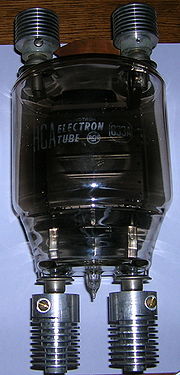
833A
Encyclopedia

Vacuum tube
In electronics, a vacuum tube, electron tube , or thermionic valve , reduced to simply "tube" or "valve" in everyday parlance, is a device that relies on the flow of electric current through a vacuum...
constructed for medium power oscillator or class B or C amplifier applications. It is a medium-mu power triode
Triode
A triode is an electronic amplification device having three active electrodes. The term most commonly applies to a vacuum tube with three elements: the filament or cathode, the grid, and the plate or anode. The triode vacuum tube was the first electronic amplification device...
with 300 watts CCS or 350 watts ICAS anode dissipation. The long grid and anode leads, plus high internal capacitance, limits this tube to 15-30 MHz maximum frequency. Being medium mu, it is normally not suitable for grounded grid operation.
Specifications
The 833A is a large tube of the type sometimes known as a "cookie jar" tube, with the envelope nominally measuring 116.8 mm (4.60 in.) in diameter and 219.2 mm (8.63 in.) in height. The 833A contains a thoriated tungsten filament rated at 10 volts and 10 amps. A pair of 833A's with adequate forced air cooling can deliver 1000 watts of CCS RF power operating as a class C amplifier plate modulated stage.A pair of tubes used in a class B modulator can deliver 1800 watts of "peak" AF power in ICAS service with speech, or 1600 watts in CCS service with music or high duty cycle operation. Two 833A's are capable of approximately 800 watts sinewave power in a class B audio amplifier or modulator. This assumes approximately 58% efficiency, 1400 watts input, and 300 watts per tube anode dissipation. The anode normally shows a dull to medium red color when operating at full power.
Internal Construction
The tube is supported solely by its two filament posts. These posts are keyed with the F1 and F2 connection having a diameter of 9.5 mm (0.375 in) and 11.1 mm (0.438 in) respectively.Characteristics
Amplification factor, 35Anode to Grid capacitance, 6.3 pF
Anode to Filament capacitance, 8.5 pF
Filament to Grid capacitance, 12.3 pF
Values for two 833s working class B as an audio amplifier or modulator.
Va max, 3 kV
Ia max, 500 mA (Averaged over one cycle of signal waveform per 833.)
Pin max, 1.125 kW (Averaged over one cycle of signal waveform per 833. This is the total input power to each 833 at maximum drive.)
Pa max, 300 W (Averaged over one cycle of signal waveform per 833. This is the maximum anode dissipation and at this power level the anode reaches a temperature of about 800 °C, and glows red hot.)
Vg1 max, -70 V
A.F. grid to grid voltage, 400 V Pk.
No signal D.C. anode current, 100 mA
Max signal D.C. anode current, 750 mA
Load resistance, (Per 833), 2.375 kΩ
Effective load resistance, (anode to anode), 9.5 kΩ
Max signal driving power, 20 W avg.
Max output power, 1.65 kW avg.
Values per 833 working class B as an R.F. amplifier with a maximum modulation factor of 1.0.
Va max, 3 kV
Ia max, 400 mA
Pin max, 450 W (This is the total input power to each 833 at maximum drive.)
Pa max, 300 W (This is the maximum anode dissipation and at this power level the anode reaches a temperature of about 800 °C, and glows red hot.)
Vg1 max, -70 V
Peak R.F. grid voltage, 90 V.
D.C. anode current, 150 mA
D.C. grid current, 2 mA
Driving power, 10 W appx.
Output power, 150 W appx.
Values per 833 working class C as an R.F. amplifier with a maximum modulation factor of 1.0.
Va max, 2.5 kV
Ia max, 400 mA
Pin max, 850 W (This is the total input power to each 833 at maximum drive.)
Pa max, 200 W (This is the maximum anode dissipation.)
Vg1 max, -500 V, nom, -300v
Peak R.F. grid voltage, 460 V.
D.C. anode current, 335 mA
D.C. grid current, 75 mA
Driving power, 30 W appx.
Output power, 630 W appx.
Values per 833 working class C as an R.F. amplifier or oscillator, (C.W. conditions, unmodulated, 50% Duty cycle.)
Va max, 3 kV
Ia max, 500 mA
Pin max, 1.25 kW (This is the total input power to each 833 at maximum drive.)
Pa max, 300 W (This is the maximum anode dissipation.)
Vg1 max, -500 V, nom, -200 V
Peak R.F. grid voltage, 360 V.
D.C. anode current, 415 mA
D.C. grid current, 55 mA
Driving power, 20 W appx.
Output power, 1 kW appx.
Grid voltages measured with respect to the mid=point of the directly heated cathode.
80% efficiency at A.F., dropping to 60% at 100 MHz when used as an amplifier.
Applications
The 833A was widely used in small (1 kW class) AM broadcast transmitters. Typically, a pair of 833As would be used in the final amplifier, plate modulated by another pair. It was also used in small induction heaters. This tube has also been used by hobbyists to construct a vacuum tube Tesla coilTesla coil
A Tesla coil is a type of resonant transformer circuit invented by Nikola Tesla around 1891. It is used to produce high voltage, low current, high frequency alternating current electricity. Tesla coils produce higher current than the other source of high voltage discharges, electrostatic machines...
.
External links
- TDP Shortwave Transmitter Tubes. http://www.tube.be/833a.html.

